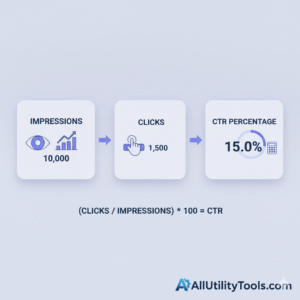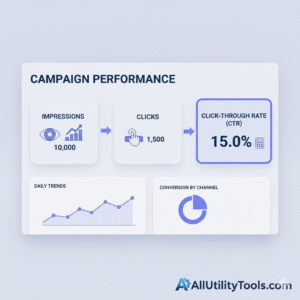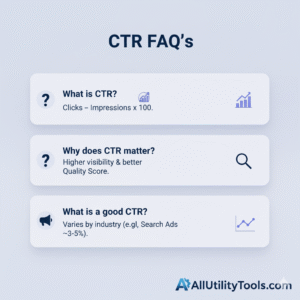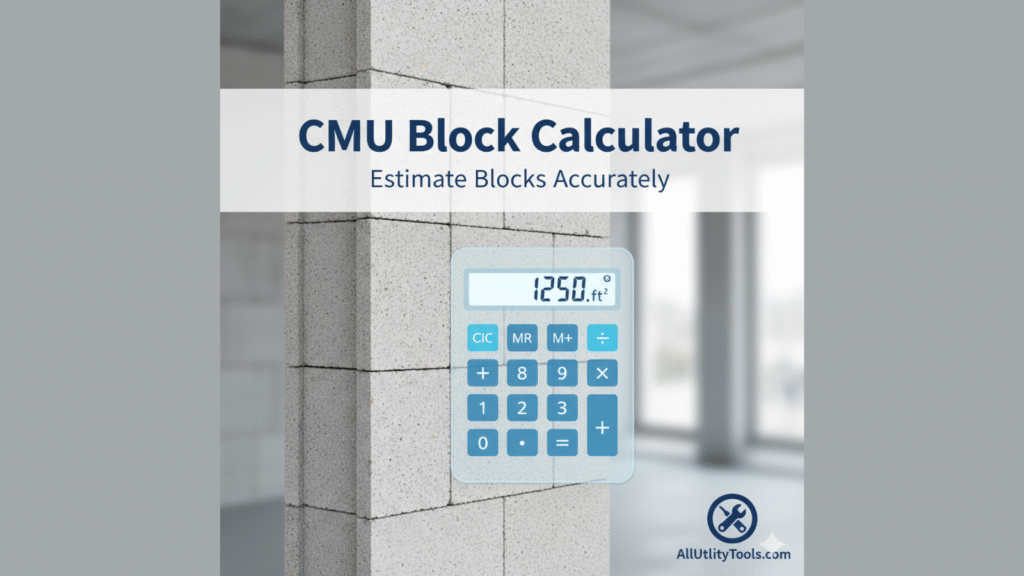1️⃣ Introduction
With the right tool, you can gain clarity, avoid guesswork, and make smarter decisions about your ads, links or content. On AllUtilityTools.com we’ve created a simple, fast, accurate CTR Calculator to help you do exactly that no headache, no complicated spreadsheets. Whether you’re a marketer, blogger, small business owner or site-owner, understanding your CTR is key to improving engagement, refining your strategy, and getting more value from your efforts. So let’s dive in, walk through what a CTR Calculator is, why it matters, how it works, how you can use it on our site and how you can get the most out of it without falling into common mistakes.
2️⃣ What Is a CTR Calculator?
In simplest terms, CTR stands for Click-Through Rate the proportion of times your link/ad/banner was clicked divided by the number of times it was shown (impressions).
A CTR Calculator is a tool that automates this calculation for you: you enter the number of clicks and the number of impressions (and sometimes other metrics), and it outputs the CTR, usually as a percentage. For example, if an ad was shown 1,000 times and clicked 50 times, the CTR is 50/1,000 = 0.05, or 5%.
Why is this handy? Because while the formula is simple, in practice you may have multiple campaigns, varying data quality, conversions, and different platforms. The calculator allows you to standardise the metric quickly, compare efforts, and benchmark performance.
Here’s what a typical CTR calculator offers:
- Fields for “Impressions” (how many times your link/ad was shown)
- Fields for “Clicks” (how many times it was clicked)
- Computes CTR = Clicks ÷ Impressions × 100 %.
- (Optional) Additional fields: date range, device, campaign, channel
- (Optional) Comparison to average/benchmark values
It’s a simple yet powerful tool to bring clarity to one of the most fundamental engagement metrics online.
3️⃣ Why Use It
Why invest the time to use (and revisit) a CTR Calculator? Here are compelling reasons:
- Measure Engagement and Relevance
CTR gives you a snapshot of how relevant your content/ad is to your audience. A higher CTR generally means your message, placement or targeting is resonating. If people see your ad and don’t click, you’re not engaging them effectively.
- Benchmarking and Comparison
When you use the calculator regularly, you can compare campaigns, links, ad variations, times of day or platforms. Which version had higher CTR? Which banner, CTA or placement is working best?
- Optimisation and Decision-Making
With CTR data you can identify weak links (literally) and optimise. If campaign A has CTR of 2 % and campaign B is 5 %, you know where to focus. Use your calculator to track changes after tweaks (headline, visuals, placement).
- Budgeting and ROI Insight
Especially in paid ad campaigns, CTR influences costs. A low CTR can signal wasted impressions — you’re paying for views that don’t convert into clicks. The calculator helps highlight inefficiencies earlier.
- Simplified Communication
Whether you report to a client, stakeholder or make decisions yourself, a clear number (CTR) is easier to share than raw data. It becomes a KPI you can reference.
In short: a CTR Calculator transforms raw numbers into actionable insight making it a smart tool for anyone serious about digital engagement.
4️⃣ How It Works
Behind the scenes (though it’s simple) it’s helpful to understand how a CTR Calculator works so you trust the results and know how to interpret them properly.

Step 1: Determine Impressions
This is the number of times your content/ad/link was shown. In display ads, impressions count each time the ad appears. In emails, you may consider delivered emails as impressions. The denominator in the CTR calculation.
Step 2: Determine Clicks
This is the number of times the content/ad/link was clicked. Note: you need to decide whether you’re counting unique clicks (one per user) or total clicks (one user may click multiple times). The choice affects the interpretation.
Step 3: Apply the Formula
CTR = (Number of Clicks ÷ Number of Impressions) × 100 %
For example: 200 clicks ÷ 5,000 impressions = 0.04 → 4% CTR. Statsig
Step 4: Interpret the Result
A higher number indicates better engagement in terms of clicks per impression. But:
- A high CTR doesn’t guarantee conversions (e.g., sales). CTR is upstream of conversion. Website+1
- What’s “good” depends heavily on channel, industry, ad format and placement. For example: display ads often have CTRs under 1%, search ads higher. Omni Calculator+1
Step 5: Use the Result to Act
Once you have the CTR, you can compare it historically, against benchmarks, or between variations. Then decide: keep, refine, pause campaign, test new design, etc.
The beauty: a CTR Calculator simply automates these first few steps you plug in data, it gives you the percentage so you can spend time analysing rather than calculating.
5️⃣ How to Use It on AllUtilityTools.com
Let’s walk through how you (our visitor/user) can use our CTR Calculator on AllUtilityTools.com. The goal: simple, fast and accurate results.
- Visit AllUtilityTools.com and locate the CTR Calculator tool (you’ll find it in the “Marketing/Analytics Tools” section).
- Select the unit format (percentage conversion) if required though generally it will default to standard display.
- Enter the number of impressions: how many times your link/ad was shown in your selected time period.
- Enter the number of clicks: how many total clicks you recorded for that same time period. Decide whether you’re entering unique clicks or total clicks our tool defaults to total clicks but you can toggle to unique clicks if you prefer.
- (Optional) Select or input campaign type (e.g., display ad, email link, search result) this helps you compare with correct benchmarks.
- Click “Calculate” (or equivalent button). Our tool will instantly show:
- Your CTR as percentage
- A visual gauge or bar showing where this CTR falls compared to typical industry ranges
- A suggestion box: “Your CTR is X% considering your industry average is Y%, you may want to…”
- Interpret the result: Use the output to decide what to do next.
- If your CTR is higher than average: good job. Consider scaling or replicating the campaign.
- If your CTR is lower: review your ad copy, CTA, placement, creative, targeting.
- Optional: Export or bookmark your result. You can save your calculation for record-keeping, reporting, or future comparison.
- Return regularly: Use the tool weekly/monthly to track trends, not just a one-time calculation.
6️⃣ Real-Life Example

Scenario: running a display banner campaign for a seasonal offer. Over a one-week period: your analytics show impressions = 20,000 and clicks = 180.
- Open the CTR Calculator on AllUtilityTools.com.
- Input: 20,000 (impressions) and 180 (clicks).
- Calculation: 180 ÷ 20,000 = 0.009 → 0.9% CTR.
- The tool shows: “Your CTR = 0.9%”.
- It also shows typical benchmarks: display ads in your niche average ~0.8%–1.2%. So you’re within range.
Interpretation:
- Your campaign is roughly average for display placement good but not exceptional.
- If you’d campaigned with search ads instead you’d likely target higher CTR (e.g., 2%+).
- Since you’re at 0.9%, you could wonder: “How do I get better at this? Should I optimize my creative? Experiment with different placement? Improve the CTA?”
- Maybe next week you try a new banner: same impressions, but click rise to 300 → new CTR = 300 ÷ 20,000 = 1.5%. That’s an improvement. Use the calculator again to monitor.
This example demonstrates you don’t require sophisticated spreadsheets. You input data, achieve a definitive metric, compare, and act. That is clarity powerful for decision making.
7️⃣ Tips / Mistakes
Here are some practical tips and common pitfalls to avoid when using a CTR Calculator (or analysing CTR) useful for maximizing value and avoiding false conclusions.

✅ Tips
- Always use consistent data: impressions and clicks should come from the same timeframe and same campaign.
- Use unique clicks if you want to measure distinct users rather than repeat clicks.
- Compare CTR to appropriate benchmarks (channel, industry, ad format) so you know if your result is good or needs improvement.
- Track CTR over time (trend) not just one snapshot improvement or decline matters.
- Interpret the tool’s suggestion/gauge output it’s fast insight, but context still matters.
❌ Mistakes to Avoid
- Mixing impressions from one campaign and clicks from another this skews the result.
- Ignoring context: a 1% CTR might be excellent for display ads, but poor for search ads.
- Focusing solely on CTR a high CTR with poor conversion or high cost might actually be worse than a lower CTR with better ROI.
- Neglecting device, placement or audience segments sometimes low CTR stems from poor placement or irrelevant audience.
- Forgetting to revisit and compare: one calculation doesn’t tell the whole story.
- Over-fixating on incremental percentage points without fixing fundamentals (creative, audience, targeting).
By following these tips and avoiding these mistakes, you’ll get far more from your CTR calculations.
8️⃣ FAQs

Q1: What is a good CTR?
A: It depends on many variables channel (search, display, email), industry, device, placement. For example, display ads might average under 1%, search ads might average around 1.5-2% or more.
Q2: Can I use the CTR Calculator for email campaigns?
A: Yes. While many calculators focus on ads, you can use impressions (emails delivered) and clicks (links clicked in the email) to calculate email CTR too.
Q3: Does a high CTR guarantee success?
A: No a high CTR means users clicked more often, but it doesn’t guarantee conversions, purchases or ROI. You must also check what happens after the click (conversion rate, quality of traffic).
Q4: What if my CTR is very low?
A: First check the data (are impressions and clicks correct?). Then review creative, message, placement, audience targeting and device mix. Use the CTR Calculator again after changes to measure improvement.
Q5: How often should I use the CTR Calculator?
A: That depends on campaign frequency, size and complexity. For ongoing campaigns you might use it weekly or monthly to track trends. For one-off campaigns you might calculate before, during and after to compare.
Q6: Can the CTR Calculator handle multiple campaigns at once?
A: Our version on AllUtilityTools.com supports entering separate campaigns or uploading batch data (if you prefer) making it flexible for one-off or bulk calculations.
9️⃣ Conclusion with CTA
Understanding click-through rate is a crucial step in improving your digital content, ads or links. The CTR calculation itself is simple, but the insight it brings can have powerful implications for engagement, cost control, optimisation and decision-making. On AllUtilityTools.com we’ve built a free, fast, reliable CTR Calculator so you don’t have to mess around with spreadsheets or manual math. Just plug in your numbers, get your result, compare, act. Whether you’re a blogger trying to test a new headline, a marketer running display ads or a small business owner reviewing email campaigns this tool gives you clarity.
👉 Try the CTR Calculator now at AllUtilityTools.com. Enter your impressions and clicks, hit “Calculate” and make your next move based on real data not guesswork. Your clicks matter. Let’s make them count.


